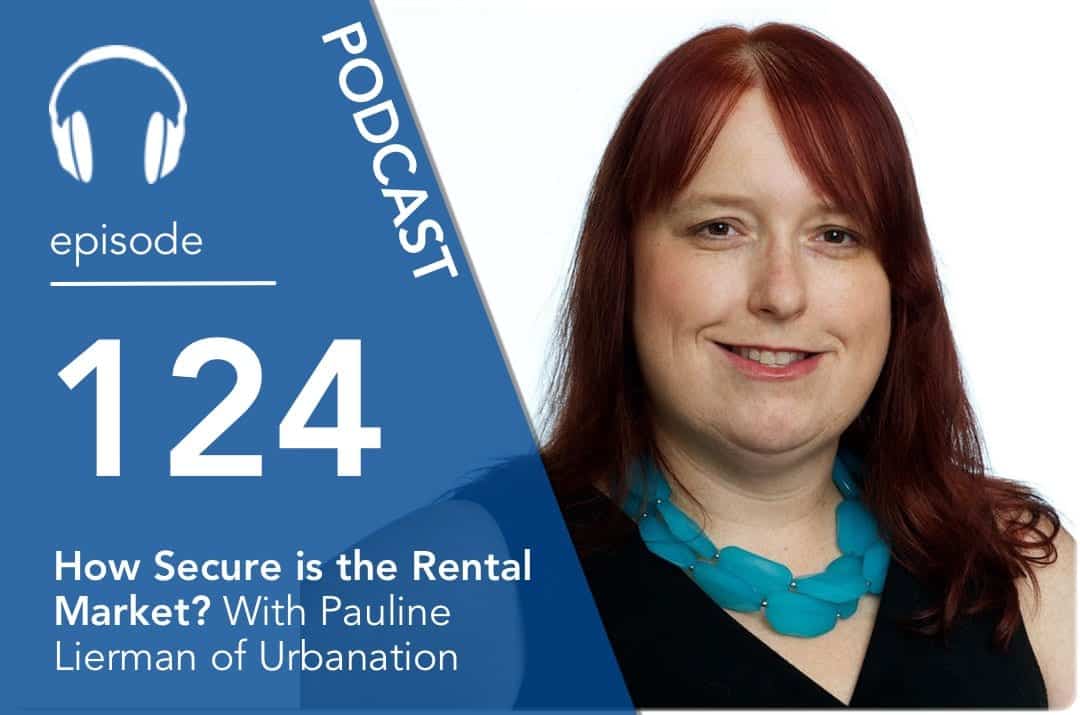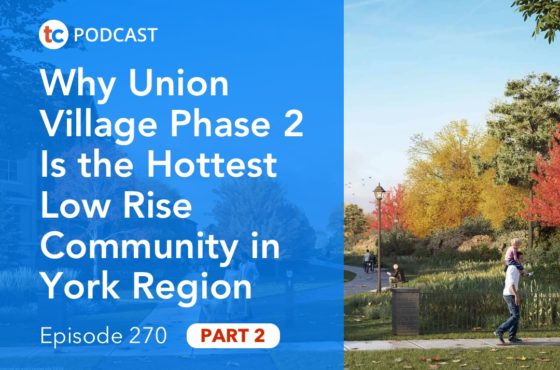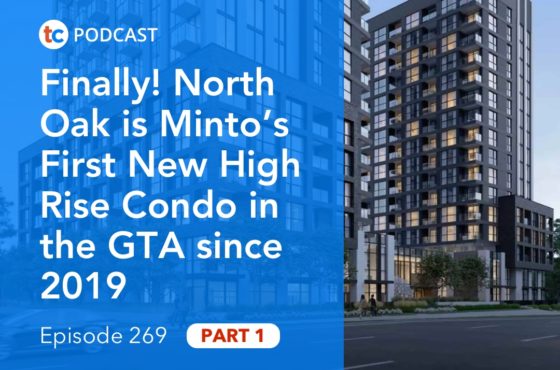How Secure is the Rental Market? With Pauline Lierman of Urbanation

Urbanation just released their year end numbers for the Toronto condo rental market. Rental rates were up an incredible 12% in the fourth quarter of 2016! Yet many first time investors still wonder if they will be able to rent out their units when completed. Find out what Pauline Lierman, Director of Market Research for Urbanation has to say.
PAULINE LIERMAN INTERVIEW HIGHLIGHTS
1:21 Will i be able to rent out my condo?
4:25 A lot of units in the pipeline. How are we going to fill all these units?
7:55 What were the key findings from the Q4 numbers report?
10:42 How did 2016 reports played out in reality versus what you predicted?
12:25 Rents go up 2% – 3% range and gone up 3, 4 times. What’s driving that?
13:44 How much new mortgage rules that came into place in the Q4 had effect on things?
16:33 Looking forward, what do you think of the purpose built rental in particular?
19:55 Is purpose built rental expected to come online in 2017?
21:30 What’s the common misconception about rental market that you want to address?
Click Here for Interview Transcript
Andrew la Fleur: You’re thinking about investing in a new condo, but you’re just not sure if you’re gonna be able to rent it out when it’s completed. What happens if it sits empty for three months? Well, find out Pauline Lierman, the director of market research at Urbanation has to say about this on today’s episode.
Speaker 2: Welcome to the True Condos Podcast with Andrew la Fleur, the place to get the truth on the Toronto condo market and condo investing in Toronto.
Andrew la Fleur: It’s my pleasure to welcome back to the show Pauline Lierman. Pauline is the director of market research at Urbanation. Pauline, welcome back.
Pauline Lierman: Thank you for having me back once again.
Andrew la Fleur: Yeah. Excited to talk to you as always. Love hearing from you about what’s happening in the market with your unique and inside expert perspective on things as the director of market research, obviously looking at the numbers that’s happening in the market on a level that pretty much nobody else in the business is doing. It’s always great to talk to you.
The number one question, as I start with, the number question that I get from investors, and I thought maybe to use it as a springboard for our conversation today, the number one question or one of the questions I get is, especially from new investors, new people looking to buy a condo is, “Will I be able to rent out my condo?” It is sort of the underlying fear of, “I’m going to invest in this thing, I’m going to buy this property and it’s going to get built and finished and then what if nobody shows up? There’s no one there in the market to … What if I’m the last person stuck with the condo that nobody wants to rent kind of thing?” If someone asked you that question, how would you respond to that?
Pauline Lierman: I think that based on the market we’ve seen this year, I wouldn’t hesitate whatsoever in terms of being able to rent out your condo. Obviously, the latest CNC numbers are on, as a data geek myself, we always look for these numbers every year, in anticipation when we get our rental numbers from them and looking at the overall rental market as a whole. The vacancy rate in the city of Toronto is 1%. I’ve never seen anything that low in number of eight years. In fact, I remember that happening very late in the 90s as well in a very constrained period where you were fighting to find rentals. In the case of that we haven’t seen as many new units complete or new units in the condo market register which makes them officially pass over into the ownership hands.
We’re not getting that surge of supply that we had thought. We still have close to 50,000 units still under construction, but the deliveries are very staged out. The market can, the industry itself can only deliver so much in the period. That’s kept the supply running a wash. You’re not competing against X number of units when you come to the market on that end.
One of the things I think you might not think about this that when we see buildings being completed, we’re seeing a little bit more of the developers wanting to hold on to units, keep them, rent them for themselves. We’ve seen a couple of developers I know that have kept, have started their own rental pools within the building, because they’re confident that they can usually rent them out. They’re not just passing them off to whatever happens in the end of the day. They see what’s happened overall in the market and they’re pretty cautious people that I know that are doing this.
Overall, if they feel confident, you see the confidence going on there, I think it’s almost … I hate to say this term because it could always change two years down the road, but right now piece of cake basically.
Andrew la Fleur: Yeah, yeah. Isn’t it funny how the conversation with the condo market, how much it can change in a year or two years. It seems that it was not that long ago where all the headlines and all the chatter in the dialog and the discourse in the industry was around, “Oh boy, look at this. What have we gotten ourselves into? We’re building way too many condos. We’ve got 50,000, 80,000, whatever the number was, 100,000 of units in the pipeline. How are we ever going to fill all these units? Clearly this must be finally the time where it’s all gonna come to a horrible end.” What do you know, here we are today beginning of 2017 and it’s the exact opposite really. We’re actually saying, “Man, we should have built more.”
Pauline Lierman: I know. We as a market research firm six months ago wouldn’t have thought this. We’ve really had to reevaluate at the end of the year where the market is at in terms of overall supply. It’s not just rental, it’s every aspect of the market. It’s the resale, it’s the new sale, just this overall widening demand for new housing in the city and the GTA, in areas that you not necessarily would expect to do very, very well or maybe would have lagged a few years ago, there still seeing strong absorptions and strong demand in markets.
What’s happened is that has accelerated into a massive rent growth. For US to see nearly 12% rent growth year over year is quite astounding for US. We’ve had to change our real perception. We used to say as a market thing that only certain city, generally in this old city of Toronto would get $3 a foot for on a monthly basis. We’ve seen that grow extended across parts of the city itself and into other parts of overall 416, even in some individual buildings in the 905 we’re being able to get $3 a foot. That is something else.
In fact, there’s areas that are touching on that $4 to $5 range which is basically Yorkville. We’ve seen an acceleration in terms of luxury rents as well.
Andrew la Fleur: Yeah, absolutely. That elusive $3 a square foot. As I look at these numbers as well and as I look at the headline chart for this report that you just put out last week on the Q4 findings, the average GTA rent for the entire GTA now is $2.77 a square foot, getting closer and closer to that … We used to, again it was only three, four years ago where we used to talk about $3 a square foot as that’s the high end of the market.
Pauline Lierman: E street and that was in Yorkville.
Andrew la Fleur: Yeah, right. Couple of small pockets, yeah you might be able to get $3 a square foot. Probably more like $2.50 or something. Now, like you said, we’re seeing $3 a square foot all over the GTA in pockets all over the place. Obviously, the whole downtown is already there.
Pauline Lierman: Certainly and certain buildings are doing well. You see testing ground of new projects along the Yonge corridor in the financial district and [inaudible 00:07:19] all those buildings are achieving extremely high rents. Certainly the Casa buildings from Cresford and 1000 Bay. These are the type of units that $3 is low. $3.50 is more realistic for them.
Andrew la Fleur: Mm-hmm (affirmative), absolutely. Let’s jump into, again, the report itself that you guys just put out. So many amazing things in it. Obviously, this is for your subscribers so if people want to get the goods they can obviously subscribe to get this. In terms of high level stuff, what are, we talked about a few of the things, but what were the key findings really, the key things that jumped out from the Q4 numbers in this report?
Pauline Lierman: I think the biggest thing is that we’ve seen the actual volume flatten out. Overall, in the year we had just over 26,602 rental units completed. I think when you find next week when we release the rest of our data, that you’re going to see a very strong symmetry in the markets, but that is interesting because it’s now come down about 4%. You’re kind of starting to see it flat line.
Rental as a market as a whole has been the real driver over the last three years. It’s seen successive gains year over year. Where this is the first time we’ve actually seen a couple of quarters where the actual rentals have actually come down slightly. They’re still high, still close to record level, but not at that growth rate we’ve seen. That of course has a lot to do with the actual registrations and the completions on that end.
At the end of year, I found that we’ve got about just about 17,700 that actually registered, so I mean they reached a final closing. That’s down 21% from a year ago. We’re really seeing less of that type of product [inaudible 00:09:16] finished. It should come up again in 2017. I’m pretty optimistic about that. That’s going forward. In the short term, I’m expecting that the market actually is going to push the average monthly rent over 2,000. It’s seen consistent gains throughout the year. We’re sitting at 1,990 right now as the average for Q4. That’s about a 7% growth very shortly. We’ve kind of seen the tightness between the listings and the leases on that end.
What we’re also noticing is we’re actually starting to see more and more continually the average size is coming down still. This in Q4 to Q4 versus last year, the average size that actually rented is 32 square feet smaller. That’s coming into play as well. We’ll see more of that especially as all the product that is under construction reaches that stage. We’ll continue see it. It might start to flatten out because certainly we see the growth this year in terms of a new condo market having slightly larger units. I’m just thinking about that in the window term, that means that 2019 and 2020 might see that growth.
Andrew la Fleur: As you look back, we’re talking about Q4 reports so now all the numbers are in for 2016, as you look back and if can recall in your memory from the reports you guys did 12 months ago and you always are looking forward and saying what you’re expecting in the year ahead, how did 2016 play out in reality versus what you predicted? What you thought was gonna happen? What were the differences in how 2016 was versus what you were predicting one year ago?
Pauline Lierman: I think that we were pretty close in terms of volume. We certainly expected, the level of activity that we saw falls quite in line with what we expected. Where we kind of got thrown was the rent. Honestly we went [inaudible 00:11:15] all the supply would actually keep the rents tempered, in the 2% to 3% growth range versus what we saw which is four times that. That was our biggest deviation from what we saw year to year from last year.
Certainly, we’ve been tracking for about almost a year and a half, two years now, the purpose built end. We thought that it would be a small but growing factor. We we’re certainly watching. We did have a number of new projects finish this year. That was a good testing ground for the appetite for the market and the demand for these type of units. We were pleasantly surprised that they were able to get, able to absorb very quickly within a six month ratio most most of these buildings or less, and they were able to actually get $3 a foot. They’re actually getting a little bit more than the condo market. That has a lot to do with the centralization of services within these buildings as well. Those are the two biggest things that we saw overall.
Andrew la Fleur: Yeah. Like you said, a year ago you were thinking rents would go up in the 2% – 3% range and they’ve actually gone up three, four times that. What’s driving that? Is that just because the number of new units coming into the market was less than expected or is there more to that story?
Pauline Lierman: There is a lot more to that. Certainly that’s part of the factor, not getting the deliverables we expected, but it’s also the economics, the economy in the city of Toronto. Certainly hiring growth has increased even on the part time level, up to part time to full time. We’ve seen job growth in the GTA. We’ve also seen a influx of increased immigration which is something that has been slowing a little last five, six years if not more. Everybody talks about 100,000, I don’t have the exact number for this year, but now that we’ve switched over the last year, we’ve seen a growth in that.
Also, intermigration. The people from Alberta who might have went out there to work for a number of years are coming back to Ontario. You’re getting that overall population demand in household formation that’s actually pushing this.
Andrew la Fleur: Very interesting. Certainly seeing a lot of people coming back from Alberta as you said. I have many stories of people … I’m sure you know people that went out there for work and they’re doing well and now they come back. The jobs are not there. They’re coming back and the job market here is very strong. How much do you think that the new mortgage rules that came into place in the fourth quarter had an effect on things?
Pauline Lierman: I think that it’s going to make it tighter in, at least, the midterm. I think that also because of the rent growth, there might be some reluctance to give up one’s unit so the turnover rate might actually slow down in that end. [inaudible 00:14:08] I can certainly relate to you’ve got great rent and you don’t want to go up there. You’re going to end up spending four or five hundred dollars more a month. Maybe that’s great if you’re sharing with a bunch of people but if you’re a young professional or a professional couple and you’re trying to save, what’s your choice there? That $500 can be put towards savings for a mortgage down the road. Certainly thinking as we have price growth in our low rise market as well.
Andrew la Fleur: I think it’s similar, just from a psychological standpoint. If you look at the consumer, the renter, the homeowner, in this hot market that we’re in, there seems to be this prevalence of this belief that the market is so hot, I don’t want to move. People almost freeze in place. It’s so expensive to move that nobody wants to move. Whether it’s renters that don’t want to move because rents have gone up but they’re looking and saying, “Wow. I’m sitting pretty at this rent I had from a couple of years ago.” The same thing in the resale market. We’re seeing listing way down. Nobody seems to want to move.
Pauline Lierman: Listing are down massively in the resale market. It actually makes me a little hesitant on the resale end how constraint it is at this point. [inaudible 00:15:38] too, renovations. I’d love to see the numbers on that, figures on annual renovation money that goes into it right now because I think it’s massive.
Andrew la Fleur: Yeah. Instead of moving, just stay and renovate. I wonder what the renter equivalent of that is, I don’t know. Get another cat or something.
Pauline Lierman: I don’t hear it really, but in New York, it’s not uncommon to renovate your unit and you’re a renter. Go to the owner and say, “I’d like to redo the bathroom.” As long as it’s okay with them, it’s pretty much like a given thing.
Andrew la Fleur: Again, it’s almost like part of the story of the city maturing, the market maturing, and it’s becoming … There’s more and more parallels with a city like New York in terms of some of these things. It’s interesting.
Looking forward like future looking, how do you think the purpose built rental in particular? I’m interested to hear what you think about that. Obviously, some investors might look at that and condo investors might say … There might be some concern that at some point there’s going to be a glut of units available as these thousands of purpose built rentals come onto the market.
How do you see the relationship playing out over the next two to three years between the purpose built market and the high rise condo market? Will the number of units completed be about the same or will we see a huge increase, because it’s like, we’re still building the same number of condos but now we’re also adding all these purpose builts? Or is it really just the condo builders are, “I’m not going to build a condo, I’m going to build a rental.” How do you see it playing out?
Pauline Lierman: I think that it will be very geography specific. I’ll give you a picture right now. We’ve seen the applications for purpose built rentals grow from 30 to 83, so 30 projects to 83 projects. That actually means 17,000 almost 18,000 new units purposed of dedicated purpose built rentals. They’re very geographically clustered. We certainly see them in the city of Toronto. We see them in some corridors where there isn’t much condo growth too. Certain areas in North York, or certain areas of Scarborough, there might be some intensification of properties. I think that the market can sustain both.
Keeping in mind that the purpose built really is kind of a drop in the bucket. We’ve seen about 4,000 units actually complete this year and they were readily absorbed. No different than the condo rental market. If you’re thinking that you’re going to be in a cluster of an area where there might be a lot of purpose built rentals, you might have to look and really look at everything in the area, but that has to meet also with the levels of demand. If the economy is still good and things are going along with that, I think that there’s room for both on that end. I honestly think that when you actually look at them, or whether it’s just applications … Plenty of applications can shift from week to week. They do all the time.
Some of the larger developments I’ve seen have this purpose built rentals and have a mix of both. This figure, you know, there might be that area for ownership and rental at the same time. I could see that because it really does vary by age and demand. Certainly, with however the crown related housing costs are, maybe you rent for a while. Then you move over to a condo and buy, or vice versa. Maybe somebody decides … They’re a little bit older and they downsize into the rental because they prefer that.
Andrew la Fleur: You mean within a same building? Rentals and condos?
Pauline Lierman: Same kind of development area. If there’s a multi-building master plan community, that could work very well. Different needs, different lifestyle stages.
Andrew la Fleur: Right. Okay. Interesting. What, in terms of purpose built rentals, are expected to come online in 2017? Is it a big jump from last year?
Pauline Lierman: Let me see. I have to go to my wonderful numbers on that one.
Andrew la Fleur: Okay. No worries. No worries.
Pauline Lierman: We had about 5100 under construction as of … We expect about half of that number to actually be completed. About 2500, 2600 units actually to be completed in 2017. That’s not a lot. That’s only maybe about five buildings overall. They’re spread out over the GTA. In the short term, not a lot. Compare that to maybe, say, 18,000 to 20,000 condo units, so not very much. It’s that broader outlook that we may start to have to look at. Typically, it takes them no difference to actually build versus a condo. It might take them less time to actually get the financing. If they’re going purpose built, and they’ve got the financing, [inaudible 00:20:56]. It’s just maybe having their planning in place. That might be something to think about to in timeframe.
I don’t expect the actual purpose built market to increase in terms of scope for another couple of years. A lot of these applications just went in, so as you know, it still takes time to go through that process.
Andrew la Fleur: Right. Good. It’s been great chatting with you as always Pauline. Just wondering if there’s something that a lot of people don’t understand or don’t realize about the rental market right now but that you wish they would? Is there a theme, or a common thing, a misconception that you come across often that you wanted to bring up or address?
Pauline Lierman: Oh man. From a data perspective? It is very much a data geek perspective. I think that the perception that everyone uses Craigslist or Kijiji. I’ve heard different things about that. We’ve actually seen the number on the MLS grow over the last year and a half, tracking the volumes. On that end … Actually, anecdotally, I’ve talked to a few people that say there’s not as much Craigslist as there is Kijiji. That’s the one thing with that, but overall, I think the perception that … I’m losing my train of thought here. You’ll have to pardon me. That the market really is going to be a wash.
Obviously, the numbers put [inaudible 00:22:37] to that. We’re certainly not breaking out of the mold for the industry in terms of delivering units. We thought at one time we wouldn’t, and everybody holds … All of a sudden, there’s like all these condos under construction and we’re going to be getting hit with 25K. Every year we look at a chart that tells us what is expected to occupy this year and it’s a massive number. Ever year that gets peeled back as it goes. Even if it’s just minor. It’s very common.
I mean, for example, we had an elevator strike for part of the year. People lose two to three months maybe on their occupancy there on that front. It’s just minor things that can hold a project back from actually reaching completion. It ends up, at the end of the day, that the number falls and we end up where we are, back where we started unexpectedly.
Andrew la Fleur: Great, yes, so true. Okay Pauline, thank you so much. We’ve ran out of time but I do appreciate your time as always. Thank you for sharing your insights. If people want to get a hold of you or learn more about Urbanation, what’s the best place for them to do that?
Pauline Lierman: Best place is urbanation.ca That will start you down the road.
Andrew la Fleur: Okay, great. Urbanation.ca. We’ll certainly include a link to that in the show notes.
Pauline Lierman: You know, our twitter feed’s good.
Andrew la Fleur: Yeah, your twitter feed is gold as always. Always a great source of insights on what’s happening in the market. Okay, Pauline, thank you so much.
Pauline Lierman: Have a great day. Thank you.
Speaker 2: Thanks for listening to the True Condo’s Podcast. Remember, your positive reviews make a big difference to the show. To learn more about condo investing, become a True Condo subscriber by visiting truecondos.com.






